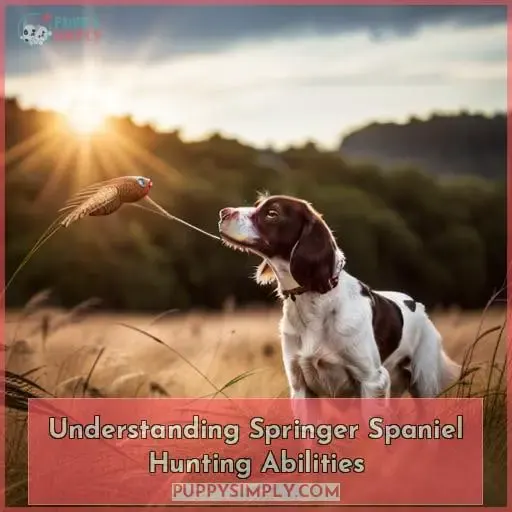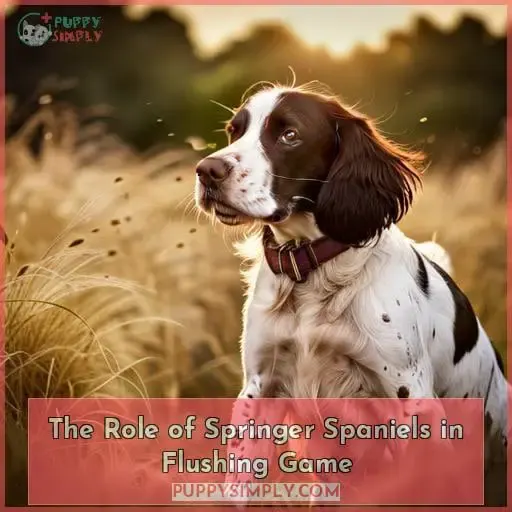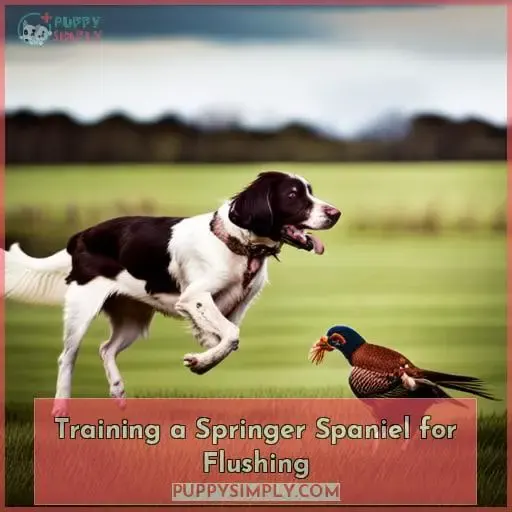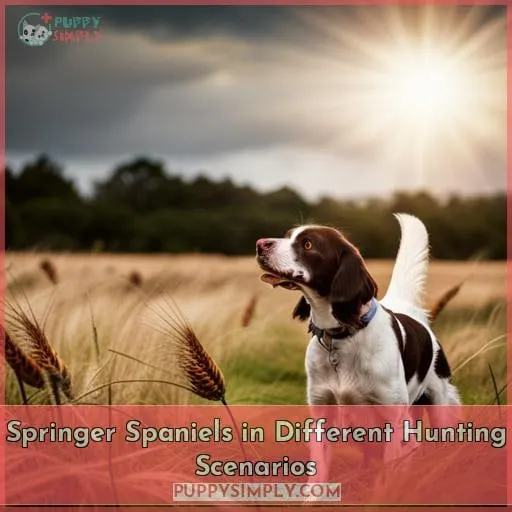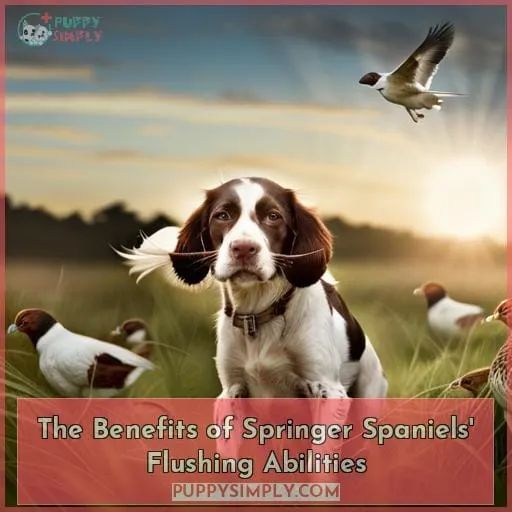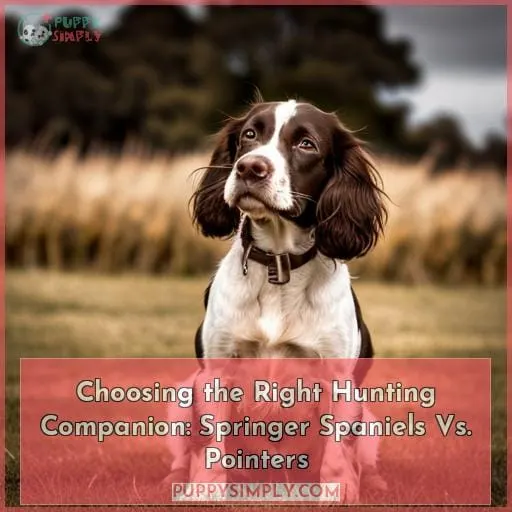This site is supported by our readers. We may earn a commission, at no cost to you, if you purchase through links.
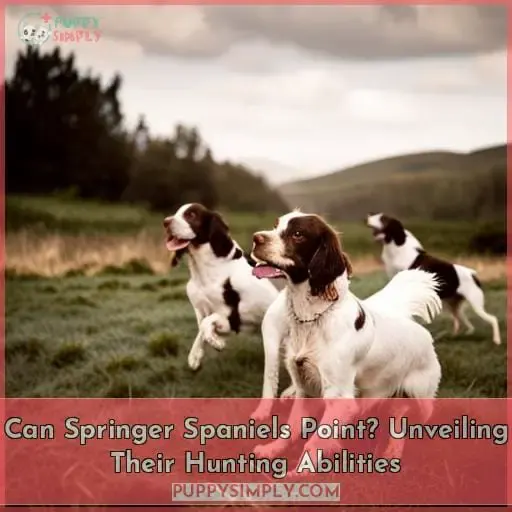 Curious if Springer Spaniels can point like other hunting breeds? Unveiling their remarkable abilities in the field, this article explores the unique hunting skills of these versatile dogs.
Curious if Springer Spaniels can point like other hunting breeds? Unveiling their remarkable abilities in the field, this article explores the unique hunting skills of these versatile dogs.
From flushing game to retrieving injured prey, Springer Spaniels excel in close-quarters scenarios with their agility and adaptability. While they may not naturally exhibit pointing behavior, we delve into whether it’s possible to train them for such tasks.
Discover how these energetic dogs contribute to shooting teams and enhance your hunting experiences.
Table Of Contents
- Key Takeaways
- Understanding Springer Spaniel Hunting Abilities
- The Role of Springer Spaniels in Flushing Game
- Training a Springer Spaniel for Flushing
- Springer Spaniels in Different Hunting Scenarios
- Can Springer Spaniels Be Taught to Point?
- The Benefits of Springer Spaniels’ Flushing Abilities
- Choosing the Right Hunting Companion: Springer Spaniels Vs. Pointers
- Frequently Asked Questions (FAQs)
- Conclusion
Key Takeaways
- Springer Spaniels are versatile hunting dogs with natural inclinations for flushing and retrieving game.
- Training a Springer Spaniel for flushing involves obedience, proximity, flushing, retrieval, scent, and wind cues.
- Springer Spaniels can be trained to point, but they are not inherently inclined to do so like traditional bird dogs.
- Springer Spaniels’ flushing abilities make them valuable assets to shooting teams and hunting experiences.
Understanding Springer Spaniel Hunting Abilities
Springer Spaniels possess versatile hunting skills that encompass both flushing and retrieving game. While they excel in seeking, flushing, and retrieving game, their natural inclination isn’t primarily towards pointing.
Understanding the differences between pointing and flushing breeds is crucial in comprehending Springer Spaniels’ unique hunting abilities.
Versatile Hunting Skills Across Flushing and Retrieving Game
Springer Spaniels excel in both flushing and retrieving game. Their versatile hunting skills make them valuable assets in the field.
While they aren’t primarily inclined to point like some other breeds, Springer Spaniels can be trained to exhibit pointing behavior if desired. Understanding the differences between flushing and pointing breeds is crucial when considering training techniques for these dogs.
Additionally, their ability to navigate dense covers, such as during grouse hunting, adds another layer of versatility to their hunting capabilities.
Differences Between Pointing and Flushing Breeds
When it comes to hunting abilities, there are distinct differences between pointing breeds and flushing breeds like the Springer Spaniel.
Pointing breeds, such as Setters and Pointers, have a natural instinct to locate game birds and freeze in a point position, indicating the bird’s presence.
Flushing breeds like Springer Spaniels excel at actively seeking out game birds and flushing them into flight for shooting opportunities.
Each breed’s behavior reflects their specific instincts and roles in hunting scenarios.
Springer Spaniels’ Natural Inclination for Flushing Game
As we delve deeper into understanding the hunting abilities of Springer Spaniels, it’s important to recognize their natural inclination for flushing game.
These spaniels possess innate instincts for seeking out and flushing game from cover, making them excellent partners in the field.
While they may not have the pointing abilities of breeds like pointers, Springer Spaniels excel at utilizing their senses and agility to locate and flush game with precision.
Their training focuses on obedience commands and proximity skills necessary for successful flushing operations.
The Role of Springer Spaniels in Flushing Game
As active seekers and flushers of game, Springer Spaniels play a vital role in hunting scenarios.
They excel at working ahead of the handler, utilizing their remarkable energy and intelligence to locate and flush out game.
In walked-up shooting situations, they rely on wind and scent to navigate rough terrain while flushing game towards the gun.
Additionally, in driven shoots where they join the beating line alongside other breeds like Cockers, Springer Spaniels help push game towards a line of guns for successful shooting opportunities.
Active Seekers and Flushers of Game
In hunting scenarios, Springer Spaniels play an essential role as active seekers and flushers of game.
Their flushing behavior is guided by specific training commands that ensure efficiency in the field.
As they actively seek out game, their nose position and tail movements indicate heightened bird activity.
While they may not inherently exhibit flash pointing like pointers, there can be individual variations among spaniels.
With their close-quarters hunting abilities and dynamic pace, Springer Spaniels offer a unique experience for those with a personal hunting preference.
Techniques Used in Walked-up and Driven Shooting Scenarios
To effectively fulfill their role as flushing dogs, Springer Spaniels employ various techniques in walked-up and driven shooting scenarios.
Utilizing the wind and scent, these field-bred spaniels work ahead of the handler to locate and flush game towards the gun.
With their keen noses and impressive speed, they navigate dense covers during grouse hunting alongside pointing dogs like Pointers and Setters.
In the beating line of driven shoots, Springer Spaniels cooperate with other breeds to push game towards a line of guns for shooting.
Working Ahead of the Handler to Locate and Flush Game
When hunting, Springer Spaniels excel by working ahead of you to locate and flush game towards the gun. Their close proximity and efficient flushing abilities are a testament to their natural instincts as versatile hunting dogs.
Through proper dog training and development, they establish a strong working relationship with their handler, utilizing their keen senses to track down hidden game in various terrains.
These sporting dogs play a vital role in ensuring successful hunts with their exceptional skills in locating and flushing game for the ultimate shooting experience.
Training a Springer Spaniel for Flushing
To train a Springer Spaniel for flushing, you must focus on developing:
- Obedience and proximity commands.
- These commands are crucial for effective hunting as they allow you to have control over your dog’s movements and ensure they stay close to the handler.
- Additionally, teaching proper flushing techniques and retrieval behaviors is essential so that your spaniel can effectively flush out game without chasing or harming it.
- Lastly, utilizing scent and wind cues will enable your spaniel to track down injured game with precision and retrieve it successfully.
Developing Obedience and Proximity Commands
To train your Springer Spaniel for flushing, it’s essential to develop obedience and proximity commands that will enhance their hunting abilities.
By teaching commands like come, sit, and stay, you can ensure your dog’s responsiveness in the field.
Additionally, practicing leash training and teaching them to heel will improve their control during hunts.
Training them to look at you on command can also be helpful in maintaining proximity while tracking game.
Teaching Proper Flushing Techniques and Retrieval Behaviors
To effectively train your Springer Spaniel for flushing, focus on:
- Instilling proper techniques and behaviors in retrieving game.
- Tailoring your training methods to individual variations.
- Utilizing lead time provided by pointing dogs.
- Incorporating tail wagging as an indicator of bird proximity.
- Teaching your spaniel to differentiate tail cues for various bird behaviors.
By honing their skills in flushing and retrieval, you can enhance their shot rates and optimize their performance as a reliable hunting companion.
| Techniques | Behaviors | Training Methods |
|---|---|---|
| Lead Time | Birdy Cues | Individual Variations |
| Shot Rates | Retrieval | Tail Wagging |
Utilizing Scent and Wind to Track and Retrieve Injured Game
By utilizing scent and wind, your Springer Spaniel can effectively track and retrieve injured game while being trained for flushing.
Through tail wagging and subtle cues, they’re able to:
- Differentiate bird proximity
- Guide hunters towards the target
Their keen sense of smell allows them to:
- Pick up on scent trails left by wounded game
- Track down and retrieve the injured animals
The combination of their exceptional nose work skills with their ability to navigate using wind patterns makes them reliable partners in hunting expeditions.
Springer Spaniels in Different Hunting Scenarios
Now let’s explore how Springer Spaniels perform in different hunting scenarios.
In walked-up shooting, these spaniels showcase their skills by working ahead of the handler and utilizing wind and scent to locate and flush game towards the gun.
When it comes to grouse hunting, they navigate through thicker cover alongside bird dogs like Pointers and Setters, offering a valuable dynamic despite not pointing like traditional bird dogs.
Additionally, in beating lines during driven shoots, Springer Spaniels play an important role by pushing game towards a line of guns for shooting.
Walked-up Shooting: Hunting in Front of the Gun Using Scent and Wind
In walked-up shooting, Springer Spaniels actively hunt in front of you, using scent and wind to locate and flush game towards the gun.
Their range can extend up to 30-35 yards as they work ahead of the handler.
With their speed and agility, these spaniel breeds excel at navigating various terrains while tracking game.
Training focused on obedience and proximity ensures that they stay within an optimal distance for effective flushing and retrieval during hunts.
Grouse Hunting: Navigating Thicker Cover Alongside Bird Dogs
As you navigate thicker cover alongside bird dogs in grouse hunting scenarios, Springer Spaniels prove to be valuable assets with their ability to flush game despite not pointing like traditional bird dogs.
Their versatility as working dogs and adaptability in dense covers make them well-suited for the challenges of grouse hunting.
With their keen sense of smell and agility, these springer spaniels excel at locating and flushing out elusive grouse from the thick cover, enhancing your hunting experience.
Beating Line: Pushing Game Towards the Guns in Driven Shoots
Join the beating line with your Springer Spaniel, a valuable companion in driven shoots as they work alongside other breeds to push game towards the guns for shooting.
As part of the beating line dynamics, spaniels play an essential role in driving pheasants and other game towards the waiting guns.
Through specialized spaniel training and their innate retrieving skills, these working breeds contribute to successful field trials by ensuring that flushed game is presented for shooting opportunities.
Can Springer Spaniels Be Taught to Point?
While Springer Spaniels aren’t inherently inclined to point like traditional bird dogs, they can be trained to exhibit pointing behavior. However, it’s important to consider their natural flushing instincts and the purpose for which they were originally bred.
Training a Springer Spaniel to point may require specialized techniques and consistent reinforcement of desired behaviors.
Inherent Flushing Instincts Vs. Pointing Abilities
To understand the hunting abilities of Springer Spaniels, it’s important to consider their inherent flushing instincts and whether they can be taught to point.
While Springer Spaniels are primarily bred for flushing game, some individuals may exhibit pointing behaviors due to their natural instincts. While some owners like to reward their Springer Spaniels with healthy snacks such as edamame for dogs, training methods that focus on developing pointing abilities in working dogs are typically more successful with breeds specifically bred for pointing rather than flushing.
Possibility of Training Springer Spaniels to Exhibit Pointing Behavior
You can explore the possibility of training Springer Spaniels to exhibit pointing behavior, enhancing their hunting abilities beyond their inherent flushing instincts.
While not naturally inclined to point like traditional bird dogs, with proper training and techniques, Springer Spaniels can learn to exhibit flash pointing behavior.
Training methods that focus on developing keen observation skills and understanding tail movements are key in teaching this desired behavior.
Ultimately, the decision to train a Springer Spaniel for pointing or stick with its natural flushing abilities depends on personal preference.
Factors to Consider When Training for Pointing Vs. Flushing
When training your Springer Spaniel, it’s important to consider the individual variations in behavior and their natural inclination towards flushing game.
Factors such as response times, hunting pace, and tail cues play a role in determining whether they can be taught to point.
Personal preference, hunting style, game species, hunting terrain, energy level,and house dog dynamics should also be considered.
Understanding canine communication and utilizing appropriate training methods are crucial for unlocking their potential within the gene pool of different Springer Spaniel types.
The Benefits of Springer Spaniels’ Flushing Abilities
Springer Spaniels possess a range of benefits with their flushing abilities in hunting scenarios.
Their effectiveness in close-quarters hunting makes them invaluable in dense covers, where they can navigate and flush game towards the gun.
Their agility and adaptability allow them to excel in challenging shooting locations, contributing to successful shooting teams and providing hunters with unique experiences.
Effective in Close-quarters Hunting Scenarios
You’re right that Springer Spaniels’ flushing abilities make them highly effective hunters in close-quarters scenarios.
- Versatile hunting skills across flushing, retrieving, and tracking game.
- Agility and adaptability in dense covers.
- Team player that works well with other hunting breeds.
Agility and Adaptability in Dense Covers
In addition to their effectiveness in close-quarters hunting scenarios, springer spaniels exhibit agility and adaptability in dense covers.
With their natural ability to navigate thick cover, these dogs are capable of quick responses and nimble movements when flushing game.
Their compact size and athleticism allow them to maneuver through challenging terrain with ease.
This makes them invaluable companions for hunters seeking game that tends to hide or take refuge in dense vegetation or wooded areas.
Valuable Contributions to Shooting Teams and Hunting Experiences
Springer Spaniels offer valuable contributions to shooting teams and hunting experiences due to their exceptional flushing abilities. These versatile dogs possess strong hunting instincts, making them adept at seeking out game and flushing it towards the guns.
Their retrieving skills further enhance their effectiveness in the field. With proper training, they can navigate various hunting dynamics, from walked-up shooting to being part of a beating line in driven game shoots.
Choosing the Right Hunting Companion: Springer Spaniels Vs. Pointers
When choosing the right hunting companion, it’s important to evaluate your personal hunting preferences and needs.
Consider whether you prefer a dog that excels in:
- Finding, flushing, and retrieving game like the Springer Spaniel
- Or one that has inherent pointing abilities like Pointers.
Understanding the distinct roles and capabilities of each breed will help determine which one aligns best with your desired hunting style.
Additionally, take into account factors such as:
- The terrain you plan to hunt in
- And the species of game you’ll be pursuing
For optimal results in your hunting endeavors.
Evaluating Personal Hunting Preferences and Needs
When choosing a hunting companion, it’s important to consider your personal preferences and needs.
Do you prefer a fast-paced hunting experience with quick shooting? If so, a flushing dog like a Springer Spaniel may be a good fit for you.
However, if you’re looking for a dog that will point birds, a Pointer may be a better option.
Ultimately, the best choice for you depends on your individual hunting style and preferences.
| Breed | Hunting Style | Training Methods |
|---|---|---|
| Springer Spaniel | Flushing | Obedience and proximity commands |
| Pointer | Pointing | Natural pointing instinct |
Understanding the Distinct Roles and Capabilities of Each Breed
Often, choosing the right hunting companion comes down to personal hunting preferences and needs.
Understanding the distinct roles and capabilities of each breed is essential for making an informed decision.
Consider factors such as:
- Tail movements
- Adaptive hunter responses
- Utilizing tail movements
- Training and development
- Personal hunting preference
Considering the Hunting Terrain and Game Species for Optimal Results
Evaluating your personal hunting preferences and needs will help you choose the right hunting companion for your next adventure.
Springer spaniels are versatile hunting breeds that excel in flushing and retrieving game, while pointers are skilled at pointing and retrieving.
Frequently Asked Questions (FAQs)
What is the difference between a springer spaniel and a pointer?
The difference between a springer spaniel and a pointer lies in their hunting roles.
While both excel at finding game,
pointers have an inherent ability to point out birds,
while springer spaniels are adept at seeking, flushing, and retrieving game.
Can springer spaniels be taught to point?
Springer spaniels can be trained to point, although it isn’t their inherent or primary function. With proper training and exposure, they’ve the potential to exhibit pointing behavior in addition to their abilities in seeking, flushing, and retrieving game.
What are the benefits of using a springer spaniel for hunting?
Utilizing springer spaniels for hunting offers a myriad of benefits.
These versatile dogs excel in finding, flushing, and retrieving game.
Their remarkable energy and intelligence make them ideal companions for walked-up shooting and driven shooting scenarios.
What are the challenges of using a springer spaniel for hunting?
Using a springer spaniel for hunting presents challenges due to their inclination toward flushing rather than pointing.
- Walked-up shooting
- Beating line roles
What is the best way to train a springer spaniel for hunting?
To train a springer spaniel for hunting, focus on basic commands like ‘come,’ ‘sit,’ and ‘turn.
Emphasize obedience and proximity in training.
Consider collaboration with other hunting breeds.
Acquire spaniels suited for your specific hunting needs.
Conclusion
While Springer Spaniels aren’t natural pointers, they can be trained to exhibit pointing behavior.
With their versatile hunting skills and eagerness to please, these dogs make excellent companions for both novice and experienced hunters.

